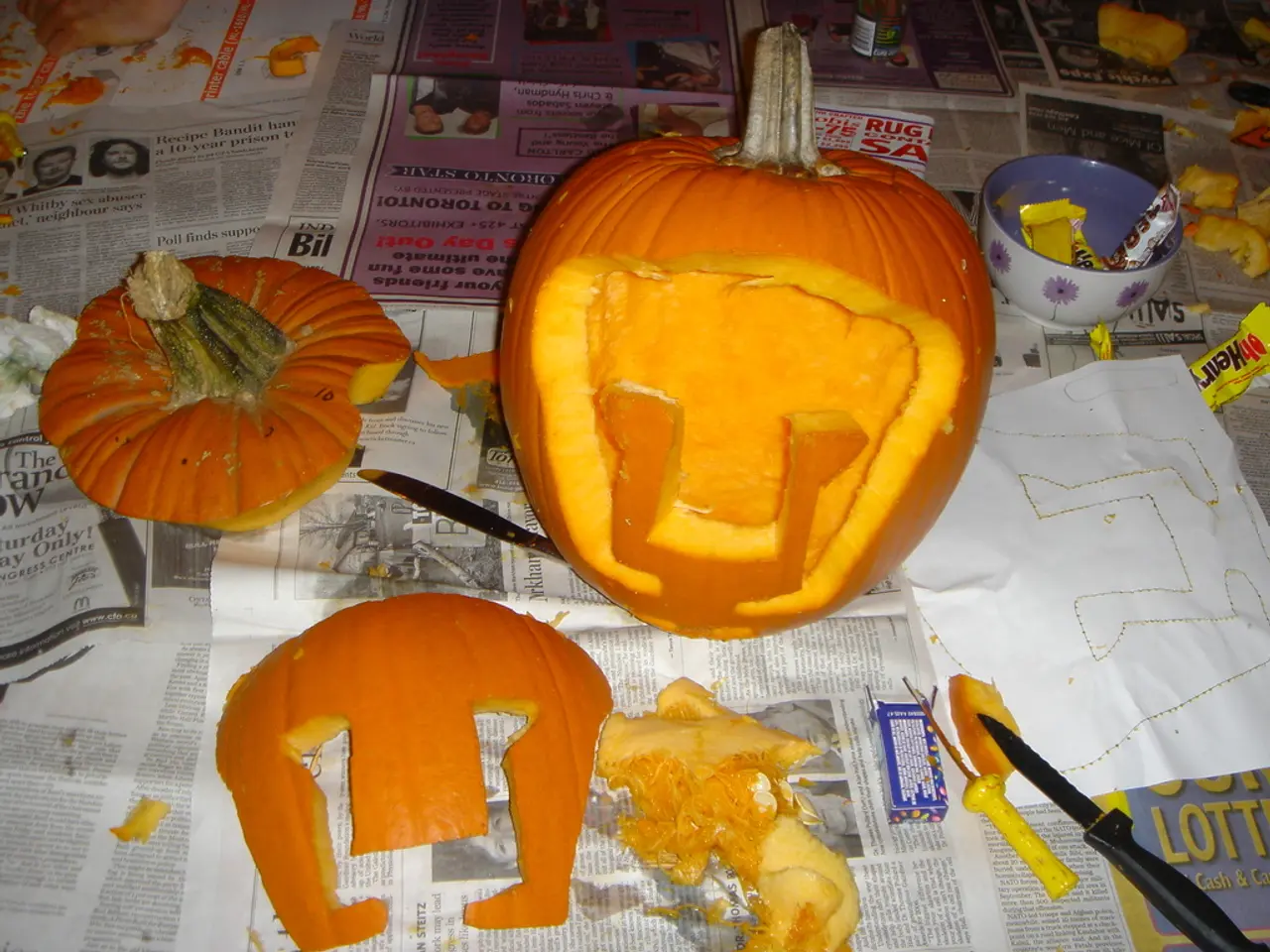Repurposing Pumpkin Guts: Creative Uses for Pumpkin Seeds
Pumpkins, a staple of autumn celebrations, offer more than just Halloween decorations. From planting seeds to composting remnants, there are numerous ways to extend the life of these versatile fruits and contribute to a greener environment.
The ideal time to plant pumpkin seeds is during late summer or autumn, but they can be planted as late as May. After a week, the dried and clean pumpkin seeds can be planted. To prepare them for planting, remove the seeds from the pumpkin, dry and clean them, and wait for a month before the last frost in the new year.
Pumpkin seeds are not just for planting; they can be flavoured with options like paprika, sea salt, or chilli flakes, and then drizzled with olive oil before baking at 180 degrees C for about ten minutes. Roasted pumpkin seeds make a healthy, hearty snack.
Once you've enjoyed the seeds, don't forget about the rest of the pumpkin. Pumpkin flesh can be used in a variety of recipes, such as soups, pies, roasted seeds, or smoothies, reducing food waste. Any pumpkin remnants, including rinds, seeds, and pulp, can be composted in a backyard compost bin or local community compost program.
Composting pumpkins prevents them from ending up in landfills, where they produce methane, a potent greenhouse gas. Instead, composting enriches soil nutrients for gardening and farming. If you have a garden, cut up pumpkin scraps can be placed directly in the soil or used as a natural fertilizer.
Halloween celebrations often result in a significant amount of pumpkin waste. In fact, eight million pumpkins become food waste each year. To minimise this impact, consider donating leftover edible pumpkins to food banks or animal shelters if possible. Avoid putting pumpkins in regular trash to reduce landfill waste and associated environmental impacts.
A carved pumpkin can also be transformed into a bowl-shape and left outside to feed birds, or it can be used as mulch on a compost heap. The 'Baby Bear' pumpkin variety, small and weighing 500g to 1kg, is perfect for soups and pies. The seeds are semi-hull less, making them suitable for toasting as a snack.
In conclusion, pumpkins offer numerous opportunities for sustainable use and disposal. By following these methods, you align with waste reduction goals, support local ecosystems, and minimise greenhouse gas emissions associated with food and yard waste disposal. Happy pumpkin season!
[1] Environmental Protection Agency. (n.d.). Composting. Retrieved from https://www.epa.gov/recycle/composting-home [2] United States Environmental Protection Agency. (2018). Advancing Sustainable Materials Management: 2017 Fact Sheet. Retrieved from https://www.epa.gov/sites/production/files/2018-02/documents/2017_fs_smm_508.pdf [3] Natural Resources Defense Council. (2018). The Truth About Food Waste. Retrieved from https://www.nrdc.org/sites/default/files/the-truth-about-food-waste-infographic.pdf
- Gardening enthusiasts might find it interesting to plant pumpkin seeds in late summer or autumn, or even as late as May, contributing to the cultivation of these fruits and promoting sustainable living.
- For those who prefer not to grow pumpkins, the seeds can be seasoned with flavors like paprika, sea salt, or chilli flakes, and then baked, providing healthy, tasty snacks for a healthier lifestyle.
- Pumpkin flesh can help reduce food waste by being utilized in various recipes, such as soups, pies, roasted seeds, or smoothies, making them perfect for home-and-garden cooks who enjoy experimenting with food-and-drink recipes.
- Moreover, all remnants of pumpkins, including rinds, seeds, and pulp, can be composted in home-and-garden compost bins or local communities, enriching the environment by reducing the amount of methane emitted from landfills and improving soil nutrients for future gardening and farming.
- In terms of preserving the environment, being mindful of Halloween celebrations is crucial, as rising from eight million pumpkins becoming food waste each year can be minimized by donating leftover edible pumpkins to food banks or shelters or repurposing them creatively, such as carving pumpkins into bird feeders or mulch for composting.
- Resources like the Environmental Protection Agency's information on composting ([1]) and environmental reports, such as the 2017 Advancing Sustainable Materials Management Fact Sheet by the United States Environmental Protection Agency ([2]), and the Truth About Food Waste by the Natural Resources Defense Council ([3]), offer valuable information for those aiming to align themselves with waste-reduction goals and minimize the associated environmental impacts of food and yard waste disposal.





